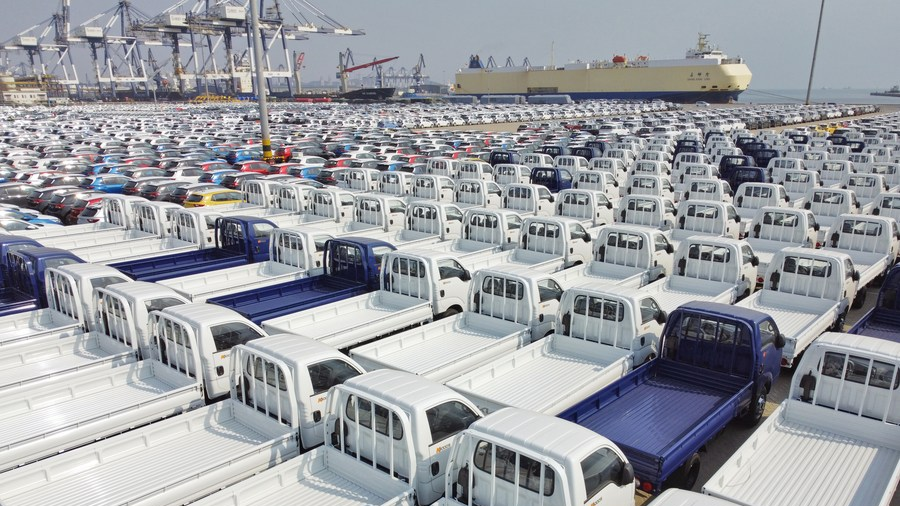
Vehicles to be loaded onto a freight ship at Yantai Port, east China's Shandong Province, March 7, 2022. /Xinhua
Vehicles to be loaded onto a freight ship at Yantai Port, east China's Shandong Province, March 7, 2022. /Xinhua
Editor's note: Maria Osterloh Mejia is an expert researcher of the Research Center for a Community with Shared Future and BRI in Peru. The article reflects the author's opinions and not necessarily the views of CGTN.
China - the second largest world economy, the main trading partner of more than 140 countries and an important generator of direct investment - is entering a new phase of development, a high-quality one, as mentioned by Xi Jinping in his report to the 20th National Congress of the Communist Party of China. This congress is celebrated as it shows the path that China will implement in every aspect in the next five years.
The world economy is facing challenges that threaten its growth this and the years ahead. In 2021 the world was recovering from the COVID-19 pandemic but this year a series of factors have come out to weigh more pressure over it with the war in Europe that has generated an energy crisis, the scarcity of fertilizers and grains to produce staple foods. In addition, the monetary policy implemented by the U.S., raising its interest rate, is causing the volatile appreciation of the dollar against the currencies of other countries and making capitals to fly, especially from emerging economies. Both reasons have made imported goods more expensive, and inflation has reached a peak in many countries not seen in years. According to the IMF's October report projections, more than one-third of the world economy would shrink and the largest economies would stall.
Before the pandemic, the world was already witnessing the start of deglobalization when the U.S. quit the Trans-Pacific Partnership (TPP) and started to impose restrictions and sanctions to Chinese products and companies declaring that China is a "strategic competitor" and a "threat." And now, the U.S. is doing everything possible to restrict sales of semiconductors to China that contain U.S. technology, harming global supply chains.
The good news is that Xi, in his speech at the 20th CPC National Congress, highlighted that China will keep its path to be a modern socialist country by 2035, and to reach that goal, it will keep supporting globalization, multilateralism and continue with the reforms and opening of its economy to keep it dynamic and resilient despite the ongoing economic decoupling started by the U.S.

Participants talk with each other at an exhibition during the 14th China-Latin America and the Caribbean Business Summit in southwest China's Chongqing Municipality, November 16, 2021. /Xinhua
Participants talk with each other at an exhibition during the 14th China-Latin America and the Caribbean Business Summit in southwest China's Chongqing Municipality, November 16, 2021. /Xinhua
As a Latin American, I think Xi's vision is optimistic and full of new opportunities for countries of the Global South. As mentioned in the beginning, China looks forward to achieving a high-quality development. This means that China is seeking a "new path of development" by implementing a series of strategies that can benefit many countries of Latin America. From Xi's report, three key points can be highlighted that are important for primary goods exporting countries.
First, in the next five years China wants to expand its domestic demand by increasing its middle-income group and to improve its income distribution system. Thanks to the already large middle-income group of China, Latin America has increased its shipments of fresh and prepared food products in the last decade. Peru and Chile are among the biggest exporters of fruits such as blueberries, avocados, grapes and cherries. China, among others Asian countries, will be an alternative destination for such supplies as the U.S. and the European Union now are affected with high inflation.
Second, China seeks to accelerate its transition to a green economy and reach carbon neutrality by 2060 by promoting the development of low-carbon industries and green consumption. China has been a great consumer of minerals in the past two decades to boost its flourishing economy. This has benefited Latin American countries which are abundant in mining resources. Now with the world economy not doing well, this announcement would keep Chinese demand steady for minerals like copper, iron, lithium that are key materials to build wind farms, solar panels and electric cars.
Third, and probably the most important, is that China wants to reach technological self-sufficiency by continuing to make large investments in research and development and cultivate a high-quality work force. This for sure will attract foreign companies that want to be part of the technological rise of China and therefore will create more employment and keep the economy growing, something that Latin America is hoping as many of these countries have China as its main export destination.
China's economic growth has beaten expectations in the third quarter of the year. It grew 3.9 percent compared to 0.4 percent growth in the second quarter, thanks to the recovery of industry production and investments in infrastructure. So, there is hope that China will continue to keep its status as a leader in the contribution to global trade and will continue with its common prosperity goals through the Belt and Road Initiative, the Global Development Initiative, and the Global Security Initiative, all of them a contribution to the world order.
(If you want to contribute and have specific expertise, please contact us at opinions@cgtn.com. Follow @thouse_opinions on Twitter to discover the latest commentaries in the CGTN Opinion Section.)